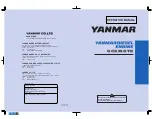
SECTION 7
ILMOR HIGH-PERFORMANCE OWNER’S MANUAL
7-12
Ilmor High-Performance Marine, LLC
© 7/2013, Version 1.0
INSPECTING AND CLEANING THE BATTERY
CONNECTIONS AND HOLD-DOWNS
1. Check that the battery post connections are clean and tight. If not,
loosen and remove the negative terminal connection first. Be careful
to avoid touching the positive terminal with the wrench or negative
connection. Then loosen and remove the positive terminal connection.
Remove the battery hold-downs and remove the battery from the boat.
Clean corrosion from the battery posts with a battery terminal cleaner.
Clean the battery with a water-and-baking-soda solution. Use care to
avoid allowing the solution to enter the battery vents. Rinse the battery
with fresh water. Note that this is a generic cleaning method. Battery
manufacturers may specify other methods of cleaning. Verify with the
battery manufacturer’s website the correct cleaning method before
undertaking any cleaning.
2. Use a battery terminal cleaning brush to remove corrosion from the
inside of the battery terminals. Clean the terminals with a water-and-
baking-soda solution and rinse.
3. Reconnect the positive terminal first, and then the negative. Tighten
the terminals. Coat both terminals completely with a thin covering
of marine grease to protect against water or any potentially corrosive
substance. Be sure that the rubber boot covers the positive terminal
completely.
NOTICE: Never install accessories or add-on equipment that is not
approved by Ilmor. Add-on equipment may adversely affect the
alternator output or overload the electrical system. Any damage caused
as a result will not be covered by the warranty.
The boat manufacturer specifies a type of marine battery with a certain
level of cold-cranking amps at 0°F (−18°C). Check the boat manufacturer’s
Owner’s Manual to determine what this specification is.
Before disconnecting the battery, be sure that the ignition key and all
accessories are in the OFF position. Also, take care to reattach battery
cables correctly to avoid reversed polarity, which is addressed in Electrical
System on page 2-3.
















































